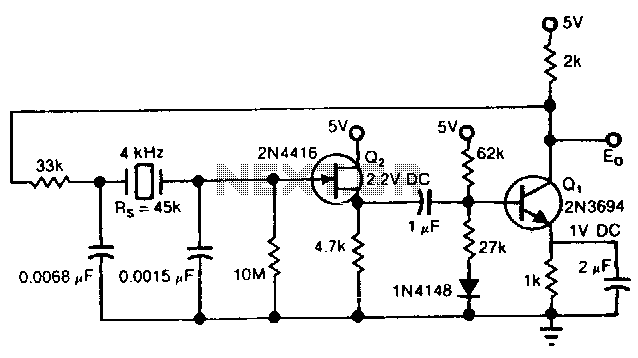
Low-frequency-pierce-oscillator

The Pierce circuit oscillates at 4 kHz. At low frequencies, the crystal's internal series resistance Rs is quite high (45 kΩ at 4 kHz). Therefore, an FET-based source follower is included to prevent Q1 from loading the crystal output.
The Pierce oscillator is a popular circuit configuration used for generating sine waves and is particularly effective at low frequencies such as 4 kHz. The operation of the Pierce oscillator relies on a quartz crystal, which serves as the frequency-determining element. At this frequency, the crystal exhibits a significant internal series resistance (Rs) of 45 kΩ, which can adversely affect the performance of the oscillator by introducing losses and limiting the output drive capability.
To mitigate the impact of the crystal's high series resistance, an FET-based source follower is incorporated into the circuit design. The source follower configuration, utilizing a Field Effect Transistor (FET), provides a high input impedance and a low output impedance. This characteristic is crucial for isolating the crystal from the load presented by the subsequent stages of the circuit, specifically the transistor Q1 in this case.
The FET source follower acts as a buffer, ensuring that the oscillation produced by the crystal is not significantly dampened by the loading effect of Q1. By doing so, it preserves the amplitude of the oscillations and maintains the integrity of the waveform. The source follower also allows for a more stable operation of the oscillator by providing a constant voltage level at the output, which is necessary for reliable oscillation.
In summary, the combination of the Pierce oscillator and the FET source follower creates a robust circuit capable of generating stable oscillations at 4 kHz while effectively managing the challenges posed by the high series resistance of the crystal. This design approach enhances the overall performance of the oscillator, making it suitable for various applications in electronics where precise frequency generation is required.The Pierce circuit oscillates at 4kHz. At low frequencies, the crystal"s internal series resistance Rs is quite high (45 Kat 4kHz). Therefore, an FET-based source follower is included to prevent Q1 from loading the crystal output.
The Pierce oscillator is a popular circuit configuration used for generating sine waves and is particularly effective at low frequencies such as 4 kHz. The operation of the Pierce oscillator relies on a quartz crystal, which serves as the frequency-determining element. At this frequency, the crystal exhibits a significant internal series resistance (Rs) of 45 kΩ, which can adversely affect the performance of the oscillator by introducing losses and limiting the output drive capability.
To mitigate the impact of the crystal's high series resistance, an FET-based source follower is incorporated into the circuit design. The source follower configuration, utilizing a Field Effect Transistor (FET), provides a high input impedance and a low output impedance. This characteristic is crucial for isolating the crystal from the load presented by the subsequent stages of the circuit, specifically the transistor Q1 in this case.
The FET source follower acts as a buffer, ensuring that the oscillation produced by the crystal is not significantly dampened by the loading effect of Q1. By doing so, it preserves the amplitude of the oscillations and maintains the integrity of the waveform. The source follower also allows for a more stable operation of the oscillator by providing a constant voltage level at the output, which is necessary for reliable oscillation.
In summary, the combination of the Pierce oscillator and the FET source follower creates a robust circuit capable of generating stable oscillations at 4 kHz while effectively managing the challenges posed by the high series resistance of the crystal. This design approach enhances the overall performance of the oscillator, making it suitable for various applications in electronics where precise frequency generation is required.The Pierce circuit oscillates at 4kHz. At low frequencies, the crystal"s internal series resistance Rs is quite high (45 Kat 4kHz). Therefore, an FET-based source follower is included to prevent Q1 from loading the crystal output.